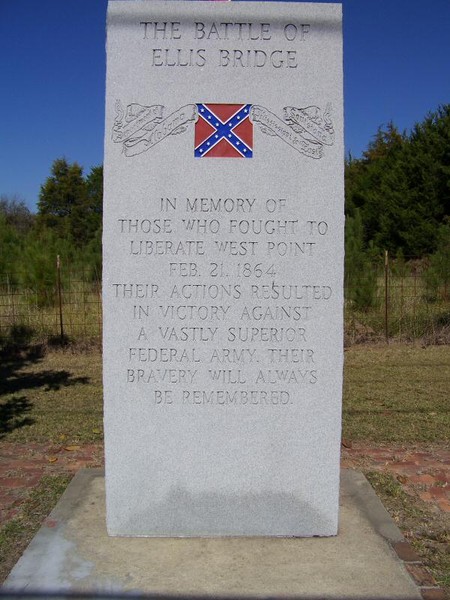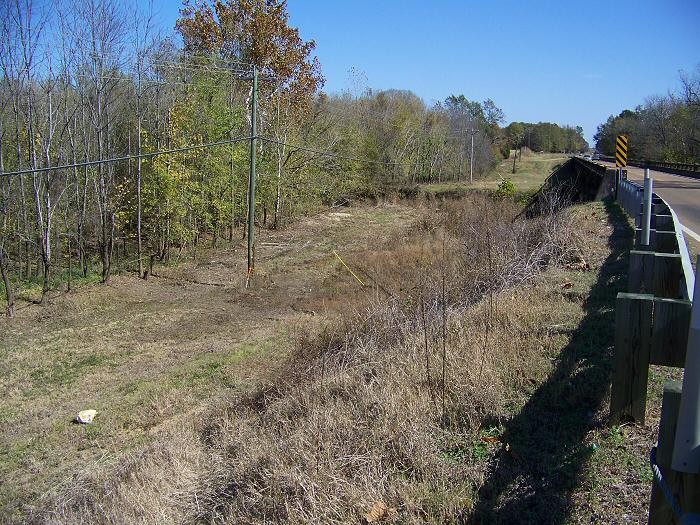Battle of Ellis Bridge Site
Introduction
Text-to-speech Audio
Images
A memorial structure built on the site of the battle, commemorating those who fought at the battle as well as recognizing the success of Nathan Bedford Forrest's unit that subdued a surprisingly overwhelming Union force.

The modern bridge built on the site where the original once stood.

Backstory and Context
Text-to-speech Audio
Battle of Ellis Bridge
During the course of the American Civil War’s bloody duration, there have been many battles that have been won by the Confederacy through superior manpower. However, during the battle of Ellis Bridge, the Confederate forces would come out victorious due to superior strategy over superior manpower. It was during this historic battle that the Confederate forces led by Nathan Bedford Forrest engaged Union forces but also pushed them back to Tennessee. The Battle of Ellis Bridge stands out as the climactic battle between General Nathan Bedford Forrest and General William “Sooy” Smith who were both fighting over the land between Oklahoma and West Point for its abundance of resources. Because of their desire to obtain these resources, the Union ignited a series of events that would cause destruction on a large scale.
During the latter stages of the Civil War, General Nathan Bedford Forrest of the Confederate forces was engulfed in several successful campaigns throughout Tennessee. Many of these campaigns included the Battle of Chickamauga, Spring Hill and the capture of seventeen hundred Federalist troops as well as Colonel Straight. Throughout his career, Forrest was known for his abilities as a cunning strategist that led to several successful campaigns through with very little resources and manpower. “In five days he had crossed the mountains fought a severe battle at Murfreesboro…by hard fighting and a successful bluff captured General Gritteden.”[1] His cunning on the battlefield was legendary even to a point where General William Sherman of the Union applauded his brilliance. “The enemy’s cavalry came down boldly at a charge led by General Forrest in person, breaking through our lines of skirmishes, when the infantry, without cause, threw away their muskets and fled.” [2]. In his first battle in the latter days of December 1861, Forrest along with three hundred men engaged the Union adversaries head-on without the amount of time to drill. However, the battle was a huge success for Forrest and his troops despite their lack of training which was largely attributed to the skill of Forrest’s cunning leadership. Forrest’s major Confederate Colonel D.C. Kelly later commented on Forrest’s warrior ethos that transformed him into a determined soldier that would never stop fighting until his mission was accomplished. “His face flushed till it bore a striking resemblance to a painted Indian warrior’s…his eyes…with the intense glare of a panther’s about to spring on his prey.”[3]
Following his victory in his first battle, Forrest was soon engaged in several other major entanglements of the Civil War. One of the battles in which he played an integral part occurred in Fort Donelson in a five day long entanglement in February of 1862. During the course of the battle, Forrest was responsible for recovering a battery of six guns along with it’s flank despite suffering a loss at the hands of the Union. Following the battle at Fort Donelson, Forrest was also present in the Battle of Shiloh in April 1862. During the battle, Forrest was in charge of reconnaissance, without being aware that the Confederate army had withdrawn he discovered Union reinforcements lying in wait and continued to fight even at the break of dawn the next morning which resulted in the surrender of that Union contingency. Following this, Forrest’s other major role throughout the course of the incident at Shiloh included a full throttle assault of Sherman’s advancing forces. Following the Confederates retreat from Shiloh, General William T. Sherman of the Union Army sought out to push back the Confederate forces. “General Sherman was attempting to press our army in retreat and the advance guard of his division was composed…of two regiments, the seventy seventh Ohio infantry and Dickey’s Fourth Illinois Cavalry.”[4]. Forrest joined with a three-hundred man cavalry charge do the advancing Union forces that was according to General J.R. Charlmers of the Confederate Army “So fierce and sudden that infantry and cavalry were all driven back together.”[5] As a result, Forrest not only delayed the Union’s advancements; but he also caused the confederacy to capture twenty five prisoners despite suffering heavy damage during the course of the charge. Three months following the events of Shiloh, Forrest was promoted to Brigadier General in July of 1862.
In the coming years of the war, General Forrest was involved in several dramatic episodes of the war that included the capture of Colonel Straight and seventeen hundred Federalist troops in March of 1863 which marked the end of the Union’s advancement in Southeastern Tennessee. However, while the Chickamauga may have put a halt on the Union’s advancement in Southeastern Tennessee, the Union was also preoccupied with its agenda towards strategic advancement in the war. While Forrest was preoccupied in this campaign, another contender William “Sooth” Smith of the Union army was involved in the course of events that took hold in the south as a result of General Sherman’s incursion into the south. Upon hearing that Smith had entered into the south, Forrest decided not to immediately engage him until Smith came to him. While waiting to meet up with Sooth’s forces, Forrest brought all his forces to the town of Starkville, Mississippi on February 18, 1864. The next day Forrest received word that Smith had reached the city of Okolona, however it was unclear what course of action they were to take. Forrest figured that Smith would attempt to cross to the Confederate locations, so he sent out two brigades. Following Forrest’s orders of the detachment of two separate brigades, one was sent to the town of Columbus, another led by his brother Jeffery to the town of Aberdeen and his riders in West Point, Mississippi. Two days following their separation Jeffery Forrest’s unit encountered Smith’s force and as a result pulled their forces back towards West Point Mississippi. Along the way, Forrest waited for reinforcements to arrive along the west of Sakatonchee Creek that was close to the Ellis’ Bridge. During his wait for reinforcements, Jeffery Forrest captured a few Union soldiers who had been capturing horses as well as destroyed a local mill in the areas north to the Ellis’ Bridge. Following the capture of these Union soldiers, Forrest ordered his unit to destroy another bridge north of the Ellis structure to be destroyed to cut off the chance of Union reinforcements.
Fearing that Forrest had a stronger army than his own, Smith concentrated his forces at the Prairie Station of the Mobile and Ohio railroad. Following this decision by Smith, he heard reports about how Forrest had reinforcements coming in led by General Stephen D Lee. In response, Smith gave permission to General Benjamin Grierson to go to Aberdeen with one brigade to find Sherman out of hope that Gerison noticed that Smith was not well and not thinking clearly out of a leadership perspective. “Gerison wrote, ‘his nervous system [had deteriorated] to such an extent as to render him absolutely sick and unable to properly command in such an emergency.”[6] To that end Grierson tried to persuade Smith into proceeding further south in his campaign. Convinced that Sherman might instead be in Vicksburg, Smith convinced himself into advancing no further and instead opted to pull his forces back towards West Point through the Ellis Bridge. To which end, Forrest set up his brother Jeffery Forrest’s brigade to the east of the Bridge another unit to the west and in addition to the two brigades, called forth reinforcements from Starkville as a backup plan. On February 21st at 8:00 in the morning, Smith and his forces began to attack Forrest’s troops and for two full hours, these two forces engaged in combat over Ellis Bridge. By 10:00AM, the Union forces called off their assault as the Confederate forces cautiously advanced.
Following the retreat of the Union forces, Jeffery Forrest informed his brother of the turn of events at the Ellis bridge, to which Forrest ordered Captain HA Tyler to pursue the retreating Federalist forces out of suspicion that the battle was to cover Smith’s retreat. With a company of 150 men, including Faulkner’s twelfth Kentucky regiment, Tyler was ordered to see what it was that the Federalist forces were up to, after which Forrest would sent all his units to immediately move north to attack the Federal Forces. Confederate Brigadier General Tyree Bell was furthermore ordered by Forrest to prevent Smith from crossing Tombigbee River. To achieve this goal, Forrest ordered Bell to bring his men across the Tombigbee at Waverly and attack the retreating Federalist forces. While pursuing the retreating Federalists, Captain Tyler meanwhile, continued to pursue through the northern area of West Point who offered little or no resistance along the way. Upon arriving at West Point, Tyler was informed that the Union troops had retreated north to the town of Okolona. Once they had arrived at Okolona, the Federalists stopped with their retreat and set up a line of defense around the town and engaged in one last fierce battle with Forrest’s troops.
Throughout the course if this fierce confrontation between the Union and the Confederate forces at Okolona, Forrest’s Confederate forces kept pushing the Union forces town of Pontotoc. Though they were pushing the Union forces back, the Confederates encountered several difficulties in order to accomplish this task. Specifically, because of the hilly terrain the Confederate forces could only muster a few troops at a time into the battlefield. In addition to the difficulty of the terrain, the Confederate forces had used up a majority of their ammunition supplies and as a result had to rely on intimidation tactics against their enemies. Taking advantage of the Confederate’s shortcomings, Smith ordered his cavalry to charge Forrest’s lines to which Forrest called “the grandest Cavalry charge I ever witnessed.”[7] Yet despite the assault made by Smith and his cavalry, Forrest’s lines were able to repel the charging Union forces. As a result of their inability to break through the lines of the Confederate forces, the Union forces and Smith retreated in a state of panic and confusion leaving behind their effects and fallen comrades on the battlefield according to Forrest who proudly said “ had fled the field in in dismay and confusion, and losing another piece of artillery, and leaving it strewn with dead and wounded men and horses.”[8] Realizing that he had achieved victory, Forrest decided not to continue to pursue the retreating Union forces and with that the Confederates had not only achieved victory but they had expelled the Yankees out of Northern Mississippi.
The Battle of Ellis Bridge thus ended with the Union forces under Smith retreating back towards Sherman’s location in Tennessee and thus secured Mississippi from the Union for the time being. More importantly, the battle was where General Nathan B Forrest made his mark on the Civil War as he was able to brilliantly gain both the upper hand and later victory against an overwhelmingly larger more well equipped force with his smaller but tenacious force. Following the failure of Smith and his units at West Point, the Meridian campaign fell apart and it would be another year before the Union would before the Union would launch another campaign in the deep south when they attacked Selma in April of 1865. The area of the battle had maintained the same farmland as it did during the course of the war as well as the road west of town. Finally, the bridge where the battle took place has now been converted to a modern roadway crossing across the current Chupuatonchee Creek formally the Sakatonchee Creek.
